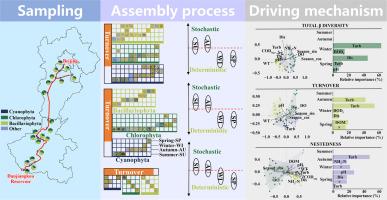跨流域调水工程中浮游植物群落组合:时间动态优于空间动态
IF 12.4
1区 环境科学与生态学
Q1 ENGINEERING, ENVIRONMENTAL
引用次数: 0
摘要
大规模引水工程在重要水资源的再分配中发挥着关键作用。尽管浮游植物在调水工程中对维持水质和生态系统稳定起着至关重要的作用,但对调水过程中浮游植物的转运机制还有待深入研究。为了更好地了解南水北调中线大型工程中浮游植物的生态过程,对其进行了系统的调查。采用β-多样性划分、零模型和广义线性模型等方法分析了浮游植物群落聚集的过程和驱动机制。结果表明,运河内浮游植物的时空变化主要受绿藻和硅藻的调控。各季节浮游植物β-多样性主要受物种更替驱动,受扩散限制影响较小。在一年的时间尺度上,随机过程占主导地位。随机过程和确定性过程的相对权重随季节而变化。夏季和秋季浮游植物群落主要受随机过程影响,冬季和春季浮游植物群落主要受确定性过程影响。季节及季节相关因子(如水温、溶解氧)对浮游植物β-多样性的影响远大于位置及位置相关因子(如高锰酸盐指数)。进一步分析表明,夏季和秋季浮游植物群落表现出随机聚集的特征。在冬季和春季,浮游植物群落的组成受浊度、流速和溶解有机质变化的显著调节。上述结果揭示了一个独特的机制:人工引水工程通过水文均匀性削弱了空间异质性,从而使浮游植物群落的主要控制轴向时间维度转移。基于以上研究结果,我们建议在长距离调水工程中实施不同季节的藻类实时监测和快速响应机制,以更有效地应对潜在的生态风险,优化水质管理,确保生态安全。本文章由计算机程序翻译,如有差异,请以英文原文为准。

Phytoplankton community assembly in an inter-basin water diversion project: Dominance of temporal dynamics over spatial dynamics
Large-scale water diversion projects play a critical role in the redistribution of essential water resources. Despite their crucial role in maintaining water quality and ecosystem stability in water diversion projects, a deeper understanding of the transport mechanism of phytoplankton in water diversion has yet to be thoroughly explored. A systematic investigation was conducted to better understand the ecological processes related to phytoplankton in the mammoth Middle Route of the South–North Water Diversion Project. Methods including β-diversity partitioning, null model, and generalized linear model were applied to analyze the process and driving mechanism of the assembly of phytoplankton communities. Results indicated that the temporal and spatial variation of phytoplankton in the canal was mainly regulated and controlled by Chlorophyta and Bacillariophyta. The β-diversity of phytoplankton throughout various seasons was mainly driven by species turnover, and was less influenced by dispersal limitation. On a year-long time scale, stochastic processes dominated. However, the relative weights of stochastic and deterministic processes varied with seasons. Phytoplankton communities were primarily influenced by stochastic processes in summer and autumn, and by deterministic processes in winter and spring. Seasonal and season-related factors (e.g., water temperature, dissolved oxygen) had a much greater impact on the β-diversity of phytoplankton than location and location-related factors (e.g., permanganate index). Further analyses showed that phytoplankton communities exhibited characteristics of stochastic assembly in summer and autumn. In winter and spring, however, the composition of phytoplankton communities was significantly regulated by the variations in turbidity, flow velocity, and dissolved organic matter. The above results revealed a unique mechanism: artificial water diversion projects weakened spatial heterogeneity via hydrologic homogeneity, thereby redirecting the main control axis of phytoplankton community assembly towards the temporal dimension. Based on the above findings, we recommend implementing seasonally differentiated real-time algae monitoring and a rapid response mechanism to more effectively address potential ecological risks, optimize water quality management, and ensure ecological safety in long-distance water diversion projects.
求助全文
通过发布文献求助,成功后即可免费获取论文全文。
去求助
来源期刊

Water Research
环境科学-工程:环境
CiteScore
20.80
自引率
9.40%
发文量
1307
审稿时长
38 days
期刊介绍:
Water Research, along with its open access companion journal Water Research X, serves as a platform for publishing original research papers covering various aspects of the science and technology related to the anthropogenic water cycle, water quality, and its management worldwide. The audience targeted by the journal comprises biologists, chemical engineers, chemists, civil engineers, environmental engineers, limnologists, and microbiologists. The scope of the journal include:
•Treatment processes for water and wastewaters (municipal, agricultural, industrial, and on-site treatment), including resource recovery and residuals management;
•Urban hydrology including sewer systems, stormwater management, and green infrastructure;
•Drinking water treatment and distribution;
•Potable and non-potable water reuse;
•Sanitation, public health, and risk assessment;
•Anaerobic digestion, solid and hazardous waste management, including source characterization and the effects and control of leachates and gaseous emissions;
•Contaminants (chemical, microbial, anthropogenic particles such as nanoparticles or microplastics) and related water quality sensing, monitoring, fate, and assessment;
•Anthropogenic impacts on inland, tidal, coastal and urban waters, focusing on surface and ground waters, and point and non-point sources of pollution;
•Environmental restoration, linked to surface water, groundwater and groundwater remediation;
•Analysis of the interfaces between sediments and water, and between water and atmosphere, focusing specifically on anthropogenic impacts;
•Mathematical modelling, systems analysis, machine learning, and beneficial use of big data related to the anthropogenic water cycle;
•Socio-economic, policy, and regulations studies.
 求助内容:
求助内容: 应助结果提醒方式:
应助结果提醒方式:


